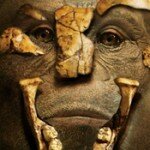Not everybody loved hominid fossil “Lucy”
It’s 150 years later, and we’re still debating Darwin’s good old Origin of Species.
A new exposition center, The Discovery Times Square Exposition, was launched in New York City, and featured the 3.2 million-year-old fossil known as “Lucy.” For many museum enthusiasts and ethnographers alike, it was a once-in-a-lifetime experience. But the exhibit didn’t close with a bang. The gallery ignited more racist fear about a common African ancestor than genuine interest on the subject of human species – a fact that boggles me, given my Ethiopian heritage, and should boggle all of you (my fellow Ethiopians?) who are reading this.
 The exhibit, “Lucy’s Legacy: The Hidden Treasures of Ethiopia,” featured installations and artwork from the culturally-rich 5-million-year history of the country where Lucy was found in 1974. Ethiopia has long been known to researchers as the cradle of mankind, beginning with the Kingdom of Aksum in the first century and ending with the reign of Emperor Haile Selassie in 1974. Visitors were able to interact with various displays about evolution and Ethiopia’s cultural traditions, before proceeding to the star of the show: Lucy, aka Australopithecus afarensis, our most complete adult human ancestor found to date.
The exhibit, “Lucy’s Legacy: The Hidden Treasures of Ethiopia,” featured installations and artwork from the culturally-rich 5-million-year history of the country where Lucy was found in 1974. Ethiopia has long been known to researchers as the cradle of mankind, beginning with the Kingdom of Aksum in the first century and ending with the reign of Emperor Haile Selassie in 1974. Visitors were able to interact with various displays about evolution and Ethiopia’s cultural traditions, before proceeding to the star of the show: Lucy, aka Australopithecus afarensis, our most complete adult human ancestor found to date.
A dimly lit room housed the 3 ½ foot skeleton of our first known hominid who threw the chimp-as-common-ancestor theory to the wind. That’s where the turbulence begins, coupled with varying criticism surrounding the Ethiopian government’s decision to bring the renowned fossil overseas in the first place. The Smithsonian Institution objected to the tour in the belief that it would be ultimately exploitative. There has also been much controversy in Ethiopia, where Lucy has been displayed to the public only twice.
The politics of cultural exploitation is, one might argue, just part of the colonial undertones of going to a museum that seeks to “discover” an African nation. But most Ethiopian officials have argued that some exposure into Ethiopia’s rich cultural significance, largely ignored in international media, is better than none. But the exhibit isn’t just about cultural significance, and according to museum staff, ticket sales were generally slow, following in the footsteps of Seattle.
“People are afraid,” a New York gallery assistant told me during my visit. “People want to believe Lucy is a hoax, since they’d rather not believe she’s really the missing link.”
Lucy, who is more than ten times older than Christianity, complicates the widely-held belief in Adam and Eve. But religion and evolution aside, the deeper issue is racial. Most striking about the gallery were not the fossils themselves, but the theoretical – the scientific, mythic, and for some, existential – implications of our common ancestor being of African ancestry. Efforts to discount Lucy might be read as a refusal to believe in Africa as the starting point for world civilization, that we are all either Africans or the descendants of Africans.
Looks like America still has some skeletons in the closet to face. Nevertheless, “Lucy’s Legacy” was a rare occasion to see Ethiopia in a new light, in a way that emphasized the nation’s complexity and deep historical importance. Though ticket sales may not have boomed, it was still, perhaps, a significant step for humankind.
Originally published in RaceWire, Colorlines blog.
Author: Adebe D.A. (10 Articles)

Race-Talk Cultural Editor Adebe D.A. is a Toronto-born writer currently living in New York. She is a former research intern at the Applied Research Center, home of ColorLines magazine. A recent MA graduate in English/Cultural Studies, she writes on issues related to race, social justice, migration, and the phenomena of culture. She currently holds the honour of Toronto’s Junior Poet Laureate and is the author of a chapbook entitled Sea Change (Burning Effigy Press, 2007). Her debut full-length poetry collection, Ex Nihilo, will be published by Frontenac House in early 2010. Visit her blog at http://www.adebe.wordpress.com.


COMMENTS